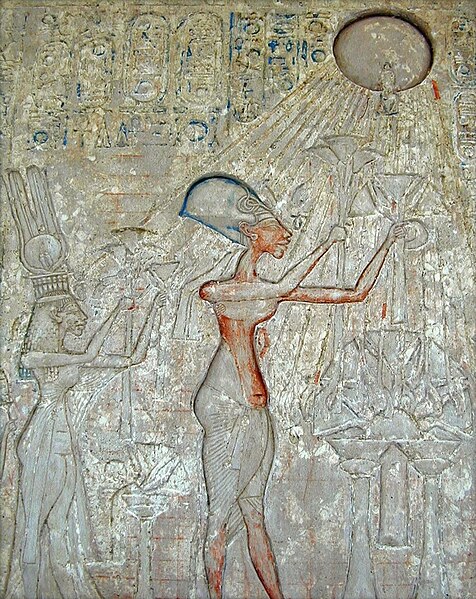Akhenaten, also spelled Akhenaton or Echnaton, was an ancient Egyptian pharaoh reigning c. 1353–1336 or 1351–1334 BC, the tenth ruler of the Eighteenth Dynasty. Before the fifth year of his reign, he was known as Amenhotep IV.
Statue of Akhenaten at the Egyptian Museum
Akhenaten, Nefertiti and their children
This limestone relief of a royal couple in the Amarna style has variously been attributed as Akhenaten and Nefertiti, Smenkhkare and Meritaten, or Tutankhamun and Ankhesenamun.
Akhenaten's elder brother Thutmose, shown in his role as High Priest of Ptah. Akhenaten became heir to the throne after Thutmose died during their father's reign.
Aten also Aton, Atonu, or Itn was the focus of Atenism, the religious system formally established in ancient Egypt by the late Eighteenth Dynasty pharaoh Akhenaten. Exact dating for the 18th dynasty is contested, though a general date range places the dynasty in the years 1550 to 1292 B.C.E. The worship of Aten and the coinciding rule of Akhenaten are major identifying characteristics of a period within the 18th dynasty referred to as the Amarna Period.
The "Great Hymn to the Aten" written from Akhenaten's point of view; the authorship of the hymn is disputed. Found in the tomb of Ay at Amarna. New Kingdom, Late 18th Dynasty. Amarna, Egypt.
Relief depicting Akhenaten and Nefertiti with three of their daughters under the rays of Aten.
Inscription from the Royal Tomb of Amarna depicting Akhenaten, Nefertiti, and two of their daughters (obscured) worshipping, or 'adoring', the Aten. New Kingdom, late 18th Dynasty. Amarna, Egypt. The Egyptian Museum, Cairo.
Akhenaten sacrificing a duck. New Kingdom, late 18th Dynasty. The Metropolitan Museum of Art, New York City.







